American Sabbatical 56: 11/27/96
Baja Thanksgiving
Thanksgiving in Baja..
Coming down into San Diego after our sojourn in the Anza Borrego John and I followed a sundog
through the conical peaks of the outer city. The solitary rainbow
spot was riding in thin clouds on the level with and about 30
degrees north of the setting sun, and it rode all the way down
to the horizon. It was John’s first sundog, and the first time
I’d ever seen just one, rather than a straddling pair. I hoped
that it was a sign. Maybe it was. Within seconds of our arrival
in Encanto the household was full of snarls and doorslams, the
neighbor dogs began yapping, and the growling highway echoed up
the canyons.
Traveling through the lives of old friends makes you confront
your personal history, and you encounter places you’ve come through,
and the might-have-beens. Some of the battles raging around us
in San Diego were hostilities we’ve won through, and maybe we
had some advice to share, but mostly all we could do was be there.
Our brief sample of the far southwest leads us to believe that
too much sunshine and manana might be dangerous for the parts
of us that like to live on the edge, or loll in the sun. Emigres
to the farthest shore have had a reputation for restless self-indulgence
since the days of Fremont, and here were some Californians we
might have become, if we hadn’t run aground in eastern Maine,
and fought through it.
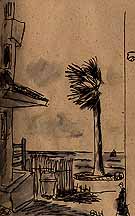
Baja Palm
|
After a week aboard a sinking household, cast in the role of liferafts
to the good old days, we were suffering from exposure, and heartache.
It hurts to see people you love drowning, and clutching at straws.
Especially when you are the straws. The culmination of our southwesting
was supposed to be a thankful weekend in Baja California, the
San Diegan’s last resort. We were going to get away to Mexico.
|
Hannah has a schoolmate, whose parents have become friends of
John and Alyce, and the whole family is working as extras in the
filming of TITANIC in Rosarito, just south of Tijuana. They had
invited the bunch of us down to their condo on the beach in Puerto
Nuevo for Thanksgiving, and we were bringing the feast and fixings.
It took us all day Wednesday to put the pieces together, and by
the time we had the ingredients crammed into the VW van it was
obvious that we had to take Red Owl with us to carry the extra
bodies. The Owl was stripped (we had emptied her for servicing),
so the thought of a customs search didn’t daunt us, and it would
be good to test her new brakes against some Mexican obstacles.
John and I had picked up a fresh bird Tuesday night, but uncertain
about keeping it good for two days, we’d jammed it into the freezer,
and it was rock-solid when we loaded it up Wednesday night. Three
coolers full of veggies and perishables, canned goods by the gallon,
bags of thisandthat, the Webber grill, charcoal, lawn chairs,
camping materials (just in case), and the frozen bird. We waddled
down the canyon out of Encanto as the sun started warming the
air Thanksgiving morning.
Neither Peggy nor I had ever been south of the border, and chasing
after a crazed VW camper may not be the best way to get the feel
of a new country. It’s the way a lot of gringos have done it,
though, and other caravans of yankee campers were lined up at
the border ahead of us. We swung out for Mexican insurance ($22.20
for four days) and a peso change, then joined the holiday surge.
The cultural divide cuts like a knife between the US and Mexico.
Lowrent California is full of junkcars, tattered palms, and faded
stucco, but the backside of Tijuana is a quantum drop below that.
Shoddy and abandoned concrete and galvanized construction, trash
and graffiti, and thick air pollution strike your eyes. It looks
like a battered outpost in the Bronx. Highway Uno skirts the border
for a ways, and it looks like the Marne come to Bed Sty. A 20-foot
corrugated steel barrier, spray-painted in political and personal
slogans, separates the joys of Tijuana from a bulldozed noman’s
land of red clay with Border Patrol Bronco’s parked here and there,
and the occasional surveillance vehicle with its conning-tower
top filled with nightscopes and intelligence arrays. Us and Them.
Then the 1 turns south through the hillside barrios of the border
city, and you are engulfed by an alien atmosphere. The very smell
in the air changes. Not unpleasantly. It’s reminiscent of a sultry
downtown summer in the late 50’s: unmuffled hydrocarbons with
a hint of salsa, and dust. The roads are full of pedestrians,
even the highways. This country moves by bus, you can flag one
down anywhere. And the Mexicans are all decently dressed. If this
is poverty, it isn’t in rags. But the infrastructure is astonishingly
rundown. It makes New York look spiffy. We had expected colorful
relief and flowery displays, but this bit of urban Mexico was
drab and disillusioned. To strangers the impression of dirt, disorder,
and decay is striking, but everyone we spoke with remarked on
how much better things are looking, or said they hadn’t noticed
the eyesores.
For all the windup we'd thought we were going to drive all day
down the peninsula, but we were barely out of the metro before
John veered off down a cement ramp and we were bumping along a
sideroad beside the ocean. And there it was: the TITANIC. Almost
full scale, almost the whole ship, totally unbelievable.. surrounded
with chainlink, production compound, and film-making hoopla. The
deck amidships was clogged with passengers in period dress, pushed
up against the railings. The cameras were rolling. Then we were
past and the looming four-stacker was just an illusory anachronism
behind us.
|
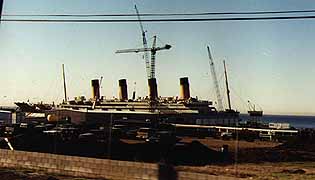
Titanic
|
We continued along the coast, with dry scrub hillsides to our
left, and hotel condos lining the headlands to our right. White
lines of surf trimmed the blue-green water and the cloudless air
was a balmy 70 degrees. We’ve been pursuing September all the
way from Maine, and here it was to perfection. Under lock and
key. Each of these vacation spas was enclosed by high walls, and
gated with full security. We turned in under the portico of a
crenelated fortress in white stucco, called the Grand Baja. Welcome
to Nirvana at Puerto Nuevo.
The Mexicans can work marvels with stone and cement. Centuries
of stucco and masonic craftsmanship make the buildings down here
a joy to behold. If the Getty reminded us how much Spanish architecture
owes to Rome, the Baja says, "and the Moors, too." It could be
North Africa. Romanesque arched windows, and Arab wind scoops.
Moorish facades and minaret turrets. Whole Mediterranean villages
in a condo-cluster. Adobe and tile may have yielded to ferrocement
and fiberglass, but the local contractors still have a gift for
meticulous detailing. And the construction is never over. Wherever
you go workmen are engaged in some small activity, but the big
projects almost never seem to get finished. Rusted steel frames
may have been erected months (or years) ago, while a portion of
the building is being blocked up today, and another section is
mostly finished out and a business going on there. There is construction
everywhere, and done jobs nowhere. Along the highway there are
astonishing drystacked rubble and flagstone walls, intricately
pieced together for miles, unmortared except for a few hundred
yards here and there. Each craftsman must be satisfied with his
small piece of the work, or he’d be heartbroken by the lack of
completion. A thoroughly foreign ethos.
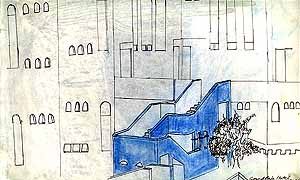
Grand baja
(Peggy)
|
The Grand Baja is a poor man’s idea of a luxury hotel: swimming
pool, jacuzzi, patio bar and grill, and tennis courts, in an interior
courtyard.. front lawn with palms and lounge furniture overlooking
a sunsplashed beach. Two five-story structures make up the majority
of the complex, one paralleling the road, on the brow of a hill,
the second about 50 yards downhill, facing the first and backing
on the beachfront. Between the two are the parking lots and amenities.
Both buildings are 50 yards long and the square is closed by a
wall at the north end, and the back of another hotel complex to
the south. The Baja is stark white, trimmed in electric blue.
Here in the upscale some of that playful color we associate with
Mexico is beginning to show. |
When we arrive a crew of workmen in uniform drab are applying
the cobalt to the accents with long-handled rollers. One of them
is standing on the rooftop, having removed a row of tiles to walk
the gable-edge. When he’s done painting he gets down without replacing
the tiles. We see other places in the complex where tiles have
been taken up and never replaced. Other workmen are patching cement
here and there, with unhurried gestures. Staff is slowly sweeping
in the courtyard or servicing the rooms. There seem to be a couple
dozen of these employees constantly in sight moving with gentle
slowness through the brilliant light.
| From the parking lot to the balcony of our hosts’ condo there
is a trek down and up of 85 steps, and we immediately begin carting
in the feast, setting up the Webber, and building a fire, like
a party of native bearers. The turkey is still rocksolid. We put
Tom in the shower with the hot on full, but are warned that the
water supply is erratic. These condos have no kitchen facilities,
and precious little else that functions. Our hosts’ unit is a
three-story stack of rooms connected by a spiral stair. To get
the beds upstairs they had to be hoisted over the outside balconies
(and the broken tiles are still there to prove it). But the rooms
are high and airy and dazzling with reflected afternoon light
off the Pacific, and the landward entrance balcony, two flights
up, is sheltered from the rising wind. |
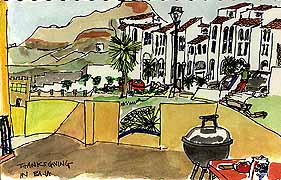
Scene of the Crime
(Bryce)
|
After a couple of hours the bird is ready for the Webber, stuffing
prepared from creative ingredients, gallons of side-dishes potted
for the Coleman stoves, and the whole crew about half lit. It
takes us about five hours to cook Thanksgiving dinner in tag-team
relays, between games of tennis, swimming, drawing and Jacuzzing.
John mans the Webber throughout. When the lime-basted bird is
finally ripped apart on the balcony we have huge appetites, and
everything is delicious. Sweet potatoes and oranges, peas and
corn, mashed potatoes, exotic stuffing. It is also our hosts’
son’s birthday and we top off the gorge with chocolate and cheesecakes.
The three pies I baked on Wednesday stay packed up for breakfast.
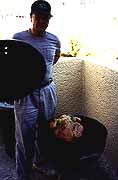
The Turkey
|
While we are juggling the preparations we get to know our hosts,
the Macintoshes, a bit. Graham is an Englishman who hitch-hiked
to the Baja out of curiosity in the 70’s, and kept returning out
of fascination. Eventually he trekked the entire perimeter of
the peninsula and published an account of his adventures, a superb
travel yarn, INTO A DESERT PLACE. Now he supplements his income
with lectures and freelance while acting in TITANIC. Bonny and
the two kids joined up with Graham in San Diego a few years ago,
and they all have cast roles in this multi-million dollar production.
They had hilarious tales to tell about the madness of moviemaking. |
The Macintoshes are cast in third class, steerage, and are amused
that the portrayed classism is maintained on and off the set.
There is an institutional classism between leading performers
and extras, in any case, and this carries down into a superiority
of hard core extras vs. the occasional cast of thousands. TITANIC
is not low budget. Graham with his Celtic red hair and dependability
has been used in more and more scenes, while Bonny and the kids,
because of their availability get lots of camera time too, and
were full of movie jargon. This has been a home-schooling experience
par excellence.
| Graham has spent days as a floating corpse in a tank, with his
costume over a wet suit, and been harnessed in for shots on the
sinking stern. The whole after section of the ship hydraulically
hinges up 90 degrees, and on one day it did so unexpectedly, breaking
a stuntman’s leg, and producing some authentic footage. The Macintoshes
relayed impressive accounts of how the crew manages herding hundreds
of extras through costuming and makeup, schedules shooting, feeds
the mob, and generally runs this quasi-military operation. The
Grand Baja has been effectively taken over by 20th Century Fox
to house extras, and daily shooting schedules for each one is
posted in the lobby via fax from the set. Busses shuttle back
and forth. |
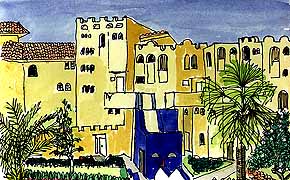
View from the hot tub
(Bryce)
|
By law the company must provide schooling for the children and
limit their daily worktime, and are also providing the funds for
daycare while the adults are on the set. Most of the shooting
is at night, so the Macintoshes are living like zombies, or like
sailors on rotating watches. They all had Thanksgiving off, miraculously,
and were delighted to have us haul in some home cooking. Bonny
complained about the incompetence of the teacher provided by 20th
Century, and Peggy’s eyes lit up. Here’s a career possibility
that would be a lark. How about a winter in the Baja as a K-12
teacher?
I’m not sure I’d like it. Between the hierarchical horsemanure
on set and the classism in Mexico my hackles would stand up too
high. All the silent staff at the hotel with downcast eyes jangles
me. And the abyssal disparity between rich (mostly gringo) and
poor (invariably native) here insults you at every turn. You can
understand why some everyday Americans come to Mexico to lord
it. Even moderate northern affluence makes you a prince in Mexico,
but the nouveau can be offensive in the extreme. Yahoos playing
king. We’re told that parts of the tropical beach on the Sea of
Cortez are like spring break year-round. To be sure there are
plenty of gringos like Graham who have deep respect for the Mexicans,
and an honest desire to share our wealth as best we can, but the
deep inequities roil my guts.
After our feast we strolled into Puerto Nuevo, the once fishing
village which abuts the hotel on the north. This is the tourist
Mexico of bright lights, jumping colors, and strolling musicians.
Puerto Nuevo calls itself the Lobster Capital of the World, which
gave us joy. Its genesis as an attraction was a restaurant serving
the once abundant California lobsters grilled and juicy. The rank
scent of singed shellfish seeping out of the back alleys put us
off this west coast treat, and we turned down the chance to try
lobster burritos. We were turkeyed to the gills, in any case.
We eyeballed the streetmarket booths full of bright-colored fabrics,
terracottas, and gewgaws. I particularly love the polychromed
wooden animals, psychedelic monsters, and mythic critters, but
there were no velvet Elvises, to our chagrin. We did some gifting,
and tried to strike the right balance between ripoff and rollover.
You are expected to haggle, but our hearts could hardly be in
it when we could see the relative poverty around us. So we’d bargain
down 20% and go away smiling. I could almost enjoy dickering,
after years of discomfort on the toymaker’s streetcorner. But
I found myself uncertain how to respond to the volunteer car-parkers
directing people into empty public spaces and expecting a gratuity.
Bonny said, "Why not pay them?", and I couldn’t answer.





